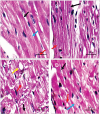Pomegranate peel extract protects against the development of diabetic cardiomyopathy in rats by inhibiting pyroptosis and downregulating LncRNA-MALAT1
- PMID: 37056985
- PMCID: PMC10086142
- DOI: 10.3389/fphar.2023.1166653
Pomegranate peel extract protects against the development of diabetic cardiomyopathy in rats by inhibiting pyroptosis and downregulating LncRNA-MALAT1
Abstract
Background: Pyroptosis is an inflammatory programmed cell death accompanied by activation of inflammasomes and maturation of pro-inflammatory cytokines interleukin-1β (IL-1β) and IL-18. Pyroptosis is closely linked to the development of diabetic cardiomyopathy (DC). Pomegranate peel extract (PPE) exhibits a cardioprotective effect due to its antioxidant and anti-inflammatory properties. This study aimed to investigate the underlying mechanisms of the protective effect of PPE on the myocardium in a rat model of DC and determine the underlying molecular mechanism. Methods: Type 1 diabetes (T1DM) was induced in rats by intraperitoneal injection of streptozotocin. The rats in the treated groups received (150 mg/kg) PPE orally and daily for 8 weeks. The effects on the survival rate, lipid profile, serum cardiac troponin-1, lipid peroxidation, and tissue fibrosis were assessed. Additionally, the expression of pyroptosis-related genes (NLRP3 and caspase-1) and lncRNA-MALAT1 in the heart tissue was determined. The PPE was analyzed using UPLC-MS/MS and NMR for characterizing the phytochemical content. Results: Prophylactic treatment with PPE significantly ameliorated cardiac hypertrophy in the diabetic rats and increased the survival rate. Moreover, prophylactic treatment with PPE in the diabetic rats significantly improved the lipid profile, decreased serum cardiac troponin-1, and decreased lipid peroxidation in the myocardial tissue. Histopathological examination of the cardiac tissues showed a marked reduction in fibrosis (decrease in collagen volume and number of TGF-β-positive cells) and preservation of normal myocardial structures in the diabetic rats treated with PPE. There was a significant decrease in the expression of pyroptosis-related genes (NLRP3 and caspase-1) and lncRNA-MALAT1 in the heart tissue of the diabetic rats treated with PPE. In addition, the concentration of IL-1β and caspase-1 significantly decreased in the heart tissue of the same group. The protective effect of PPE on diabetic cardiomyopathy could be due to the inhibition of pyroptosis and downregulation of lncRNA-MALAT1. The phytochemical analysis of the PPE indicated that the major compounds were hexahydroxydiphenic acid glucoside, caffeoylquinic acid, gluconic acid, citric acid, gallic acid, and punicalagin. Conclusion: PPE exhibited a cardioprotective potential in diabetic rats due to its unique antioxidant, anti-inflammatory, and antifibrotic properties and its ability to improve the lipid profile. The protective effect of PPE on DC could be due to the inhibition of the NLRP3/caspase-1/IL-1β signaling pathway and downregulation of lncRNA-MALAT1. PPE could be a promising therapy to protect against the development of DC, but further clinical studies are recommended.
Keywords: IL1β; NLRP3; TGF-β; caspase-1; long non-coding RNA-metastasis-associated lung adenocarcinoma transcript-1; pomegranate peel extract.
Copyright © 2023 Abo-Saif, Ragab, Ibrahim, Abdelzaher, Mehanyd, Saber-Ayad and El-Feky.
Conflict of interest statement
The authors declare that the research was conducted in the absence of any commercial or financial relationships that could be construed as a potential conflict of interest.
Figures







Similar articles
-
Pyrroloquinoline quinone ameliorates diabetic cardiomyopathy by inhibiting the pyroptosis signaling pathway in C57BL/6 mice and AC16 cells.Eur J Nutr. 2022 Jun;61(4):1823-1836. doi: 10.1007/s00394-021-02768-w. Epub 2022 Jan 8. Eur J Nutr. 2022. PMID: 34997266 Free PMC article.
-
Melatonin alleviates cardiac fibrosis via inhibiting lncRNA MALAT1/miR-141-mediated NLRP3 inflammasome and TGF-β1/Smads signaling in diabetic cardiomyopathy.FASEB J. 2020 Apr;34(4):5282-5298. doi: 10.1096/fj.201902692R. Epub 2020 Feb 17. FASEB J. 2020. PMID: 32067273
-
Long noncoding RNA MALAT1 regulates renal tubular epithelial pyroptosis by modulated miR-23c targeting of ELAVL1 in diabetic nephropathy.Exp Cell Res. 2017 Jan 15;350(2):327-335. doi: 10.1016/j.yexcr.2016.12.006. Epub 2016 Dec 10. Exp Cell Res. 2017. PMID: 27964927
-
Potential diabetic cardiomyopathy therapies targeting pyroptosis: A mini review.Front Cardiovasc Med. 2022 Aug 18;9:985020. doi: 10.3389/fcvm.2022.985020. eCollection 2022. Front Cardiovasc Med. 2022. PMID: 36061533 Free PMC article. Review.
-
Recent advances in pomegranate peel extract mediated nanoparticles for clinical and biomedical applications.Biotechnol Genet Eng Rev. 2024 Dec;40(4):3379-3407. doi: 10.1080/02648725.2022.2122299. Epub 2022 Sep 18. Biotechnol Genet Eng Rev. 2024. PMID: 36117472 Review.
Cited by
-
Diabetic cardiomyopathy: Importance of direct evidence to support the roles of NOD-like receptor protein 3 inflammasome and pyroptosis.World J Diabetes. 2024 Aug 15;15(8):1659-1662. doi: 10.4239/wjd.v15.i8.1659. World J Diabetes. 2024. PMID: 39192865 Free PMC article.
-
In Vitro Anti-diabetic Activity of Pomegranate Peel Extract-Mediated Strontium Nanoparticles.Cureus. 2023 Dec 30;15(12):e51356. doi: 10.7759/cureus.51356. eCollection 2023 Dec. Cureus. 2023. PMID: 38292989 Free PMC article.
-
LncRNA GAS5 restrains ISO-induced cardiac fibrosis by modulating mir-217 regulation of SIRT1.Sci Rep. 2024 Apr 1;14(1):7652. doi: 10.1038/s41598-024-58239-9. Sci Rep. 2024. PMID: 38561456 Free PMC article.
-
Long Non-Coding RNAs in Diabetic Cardiomyopathy: Potential Function as Biomarkers and Therapeutic Targets of Exercise Training.J Cardiovasc Transl Res. 2025 Jan 9. doi: 10.1007/s12265-024-10586-8. Online ahead of print. J Cardiovasc Transl Res. 2025. PMID: 39786669 Review.
-
The multiple functions and mechanisms of long non-coding RNAs in regulating breast cancer progression.Front Pharmacol. 2025 Mar 28;16:1559408. doi: 10.3389/fphar.2025.1559408. eCollection 2025. Front Pharmacol. 2025. PMID: 40223929 Free PMC article. Review.
References
-
- Ahmed S. R., El-Sherei M. M., El-Dine R. S., El-Toumy S. A. (2019). Phytoconstituents, hepatoprotective, and antioxidant activities of Euphorbia cooperi N. E. Br. Egypt. J. Chem. 62, 831–840.
-
- Akuru E. A., Chukwuma C. I., Oyeagu C. E., Erukainure O. L., Mashile B., Setlhodi R., et al. (2022). Nutritional and phytochemical profile of pomegranate (“Wonderful variety”) peel and its effects on hepatic oxidative stress and metabolic alterations. J. Food Biochem. 46 (4), e13913. 10.1111/jfbc.13913 - DOI - PubMed
LinkOut - more resources
Full Text Sources
Miscellaneous

